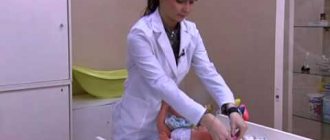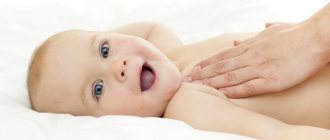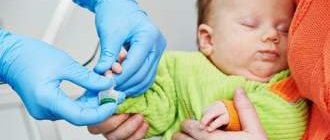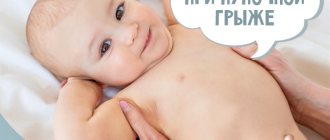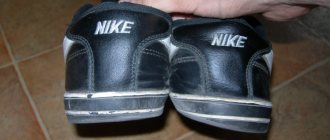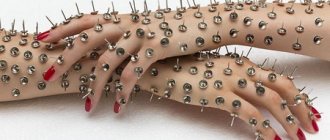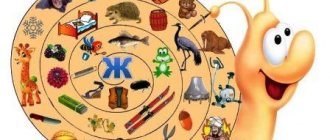Baby massage
A joyful event has occurred in your family - a baby has been born! And now almost all of life is subordinated to this little person: there is so much to do during the day, and he requires so much attention and care. Studies have shown that establishing contact between mother and baby
from a very early age, a positive tactile and loving connection between them
has a beneficial effect on the relationship
, ensuring healthy interaction and development in the future.
The newborn baby needs sensory interaction for physical, psychological, emotional development and well-being. Therefore, massage is so necessary from the first days of life. Loving touches heal both the physical and spiritual body.
What kind of massage is recommended for children under 1 year old and its benefits.
There are three types of massage:
- Preventive massage is a massage that promotes the baby’s development and is performed on the parents’ own initiative, after consulting with a pediatrician. This type of massage is given to a healthy child, starting from three months of his life.
- Medicinal;
- Corrective.
Both therapeutic and corrective massage are prescribed by a doctor (pediatrician, neurologist, surgeon or orthopedist) depending on the child’s pathology. In order to identify a disease or deviations from developmental norms at an early stage, I recommend showing your baby to specialists from the age of 2 months, explaining what has alerted you and what worries you, as well as asking the appropriate questions. A highly qualified specialist will examine the baby, make the correct diagnosis if the child is sick or reassure you if the baby is healthy.
So how to properly massage a baby?
First of all, don't be afraid. The massage begins with simple frozen touches or supports - this is when you simply place your hands on your baby. He calms down because he feels you are nearby, hears your smell, feels your touch, and this gives the baby a feeling of comfort and confidence. It should be noted that tactile interaction with the baby should occur against the background of a good (positive) relaxed state of the mother. And then your touch will stimulate the response of all the baby’s senses.
Diseases that can be cured in a baby with massage:
- problems with the musculoskeletal system: clubfoot, scoliosis, flat feet, dysplasia.
- diseases of a therapeutic nature: hernia, hypotonia, hypertonicity, rickets, malnutrition and torticollis.
- respiratory diseases: bronchitis, bronchial asthma, pleurisy, rhinitis.
- problems with the gastrointestinal tract
- diseases of the central nervous system.
Attention! Do not make a diagnosis yourself and do not self-medicate! Remember that the diagnosis can only be made by the attending pediatrician, preferably with a good reputation and long-term experience!
How to make your baby like it
The massage should be a soothing and pleasant procedure for both the parent and the baby, and the movements should be very soft, smooth, flowing into one another. Every parent should realize that it is not he who “guides” the massage, but his baby, always taking into account the child’s individuality.
Movements when massaging a newborn
● First, stroking massaging movements are performed with the fingertips and palms of the hands. With them you evenly distribute the oil over the surface of the body, warm up the muscles, stimulate blood circulation to the surface of the skin and vice versa, improve lymphatic drainage.
● Then you make slow, rhythmic twisting movements with your fingertips and the soft area of your palms, which allows you to engage deeper muscle layers and improve muscle tone. These movements are associated with the word “knead” (dough).
● By kneading we achieve relaxation of tense muscles, restoration of muscle tone in case of hypotonia, improvement of blood flow to the muscles and removal of toxins from them.
● These movements are replaced by rubbing - small circular movements performed with the pads of the thumbs or all fingers. Rubs are applied to a specific area and done slowly with less force. This allows you to increase blood circulation in the massaged area, relieve tension and improve blood flow.
● And we finish the massage with stroking again.
How to massage a newborn? Basic massage techniques
Babies love established routines and repetition.
So if you massage your baby the same way every time, he will know what to expect and enjoy the experience.
- Start massaging the baby from the legs, gradually moving to the body, ending with the head. Feet are a great place to start a massage session because your baby is used to having their feet touched when their diaper is changed.
- Pour a few drops of cream or oil onto your hands. Heat the oil or cream by rubbing it between your palms.
- Rub it very gently into your baby's skin, starting from the feet.
- Work your way up your legs. You can then gently stroke from your hips to your toes.
- Follow the same sequence on your hands. Massage them from shoulders to toes. It is useful to combine massage with light exercises.
- Exercise for fingers. Lightly pinch a finger between your thumb and forefinger and slowly bend and straighten it. Repeat with each finger. It is useful to accompany such exercises with nursery rhymes.
- Exercises for the chest and tummy include circular strokes in a clockwise direction. Circular stroking of the tummy, done with gentle pressure, helps move food through the digestive tract.
- Hold your child's legs below the knee and, as you lift your legs up, gently press your knees onto your stomach. This will help the excess gases escape.
- Finish massaging the front of your baby's body with extensive strokes from the chest to the hips.
- Turn your baby onto his stomach to massage his back.
Use large, counterclockwise circular motions, moving up your back from the base to your shoulders. Do not press on the spinal column area. This may harm your baby. - Finish the back massage by stroking with a large amplitude from the shoulders to the hips, as you did on the front of the body.
Doing massage correctly
You can massage your baby at any time as long as the baby is ready to receive it. It is important that the baby is not too hungry and tired, and that the massage itself is performed in a quiet, warm, ventilated room, without drafts or distractions. Natural vegetable oils are used for massage. But before the first session, it is important to make sure that the child is not allergic to this oil (to do this, apply a drop of oil to the child’s skin before the massage session and check the reaction). It is important to maintain your own hygiene (clean hands, short-cut nails) and the safety of your baby (remove jewelry that could inadvertently injure him).
You can learn how to massage a baby, properly organize tactile interaction with your baby, and take a course in professional massage at the Educational Research Center.
Types of massage
Depending on the goal pursued, massage is divided into the following types:
- medicinal;
- prophylactic;
- therapeutic and prophylactic.
Therapeutic massage should be performed by a specialist. It can be prescribed for the following diseases identified in the baby:
- hypertonicity or hypotonicity;
- hip dysplasia;
- congenital dislocation of the joint;
- acquired or congenital clubfoot;
- umbilical hernia;
- diseases of the central nervous system;
- flat feet;
- leg deformation (X- or O-shaped).
Each disease has its own special massage techniques, which, as a rule, differ from each other.
Preventive massage is recommended for all newborns, unless there are contraindications. Sessions of such a massage can improve blood circulation and appetite, normalize metabolism, and normalize breathing. In children with increased excitability, behavior stabilizes and sleep normalizes. It turns out that massage can reduce the level of the hormone cortisol in the body. Cortisol is a stress hormone; when its levels are high, the body’s immune defense is destroyed. Consequently, under the influence of massage, the child’s immunity also improves.
Since preventive massage is carried out in most cases by the parents themselves, its sessions are an additional way for the baby to contact mom or dad. Undoubtedly, this will improve the psychological state of the baby.
Therapeutic and preventive massage , like therapeutic massage, is prescribed by a doctor and carried out by specialists. It involves massaging the entire body, paying special attention to problem areas. This type of massage can normalize blood circulation, improve the functioning of the cardiovascular system, correct the defective condition of bones and muscles, and eliminate intestinal colic. It is also recommended for diseases of the respiratory, genitourinary and digestive systems. Therapeutic and preventive massage has a beneficial effect on the baby’s motor abilities. The child will quickly learn to roll over, sit up and crawl.
Benefits / advantages of massage
There are many receptors on our skin that, when irritated, send signals to the brain. This is how the work and development of the entire human nervous system is stimulated, and massage takes a leading position here. After all, it is during a massage session that the most nerve receptors are irritated.
Massaging the body improves blood circulation, and this has a positive effect on the condition of any internal organ. That is why preventive massage sessions are recommended for all children in their first year of life.
For infants, massage replaces gymnastics. In addition, newborns have not yet developed enough auditory and visual abilities; the whole world is felt through touch. Therefore, it is massage that develops the baby’s emotional state and the ability to perceive the world around.
Pediatricians consider massage a reliable means for the prevention of various diseases, since the coordinated functioning of all organs depends on it.
We have already mentioned the beneficial effects of massage procedures on the immunity of a newborn. So, as a result of this influence, the child will be less likely to “catch” various infections and colds.
Massage sessions are beneficial for the digestive system, eliminating intestinal colic and constipation in children. They also have a beneficial effect on the musculoskeletal system, helping to form correct posture and, if necessary, restore physical fitness.
In what cases is massage needed?
Massage for newborns is usually prescribed for the following diseases:
- malnutrition;
- rickets;
- muscle hypertonicity;
- valgus and flat valgus foot deformities;
- residual reflexes of the newborn;
- tremor of various parts of the body;
- CNS lesions;
- cerebral palsy;
- umbilical hernia;
- hip dysplasia;
- torticollis;
- clubfoot, flat feet, leg deformity;
- scoliosis;
- chest deformity.
A course of massage can also be prescribed as part of the treatment of bronchial asthma, pneumonia, fractures of the limbs, etc. It is also indicated for increased tone of the limbs and constipation.
However, if the baby has no special indications for massage, it can and should be done independently at home. Naturally, observing the necessary conditions, and after consulting with a pediatrician.
Contraindications
- Any type of massage will not bring any benefit if the baby has an elevated body temperature. It is contraindicated for various injuries or diseases of the skin (especially pustular in nature), increased fragility of bones, diseases of the circulatory system, and acute respiratory viral infections.
- It is advisable to avoid massage procedures in the midst of the acute stage of any disease.
- If there is an umbilical hernia, massage should be carried out under the close supervision of a doctor, since in this case the possibility of pinching the hernia must be excluded.
- For children with heart disease, massage sessions should be supervised by a pediatric cardiologist.
- It is not recommended to perform a massage if the baby is nervous, since this condition causes increased muscle tone.
In any case, a massage course must be prescribed by a doctor; “amateur” is unacceptable.
